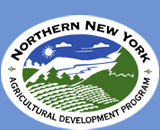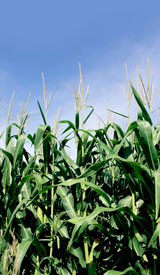


March 16, 2007
Contact: Sally A. Flis, Everett D. Thomas, Miner Institute,
518-846-7121 x126, 115
Jpg of copper application cornfields at Miner Institute available from
karalynn@gisco.net
NNY Copper & Crops Research Results Cause Concern with Grass, not
Corn
Chazy, NY -- Recycling manure as fertilizer on farm fields provide crops
with nutrients. Some crops, however, may be adversely affected by dairy
cow manure that contains a copper sulfate solution used in cow footbaths
to prevent lameness and disposed of into manure storage and later
applied to farm fields. Researchers at the William H. Miner Agricultural
Research Institute have released the results of the first year of
research on how manure-based copper concentrations affect grass and corn
crops. The Northern New York Agricultural Development Program is funding
the research. There has been no previous research to determine how
copper in sulfate form in dairy manure affects crop development on
different soils.
Orchardgrass and timothy, grown in greenhouses at Plattsburgh State
College, responded the same to treatments with a solution of the
equivalent of zero, 5 lbs/acre of copper and 10 lbs/acre of copper in
manure applied based on phosphorus requirements indicated by soil
testing. Field plots of one short-day corn hybrid and one long-day corn
hybrid at Miner Institute received zero, 8.1 lbs/acre of copper and 16.3
lbs/acre of copper in a total application of 28 gallons of liquid manure
applied at a rate of 4900 gallons/acre.
�Our greenhouse research for 2006 shows a decrease in orchardgrass and
timothy grass shoot weight that is equivalent to a loss of 339 lbs of
production per acre,� says Sally A. Flis, the University of Vermont
Ph.D. graduate student working at the William H. Miner Agricultural
Research Institute in Chazy, NY (Clinton County).
Flis says the Northern New York research project shows that as copper
levels increase timothy and orchardgrass crop yield may be negatively
affected, but a one-year application totaling up to 16 lbs/acre of
copper from dairy manure applied at a rate of 4900 gallons/acre does not
appear to negatively affect corn growth, yield or plant copper
concentration, Still, Flis says, �continued research is needed on how
multiple high application rates of copper sulfate affect corn since a
single application of dairy manure to corn is not a common practice.�
The New York State Department of Environmental Conservation has set a
lifetime field load limit for copper at 74 lbs/acre.
The trials at Miner Institute with timothy and orchardgrass on sandy
loam soil showed that as copper concentrations in manure applications
increased the desired regrowth of shoots (tillering rate) and the dry
weight of shoots and roots decreased. Copper toxicity affects roots
first and concentrations in the grasses� roots showed an increase as
copper concentrations as manure applications increased. Copper levels in
the shoots of the timothy and orchardgrass crops increased but were
within normal range for concentration of the mineral in the plants (0-50
ppm).
�The results of this research cause concern about how continued disposal
of copper sulfate footbaths into manure systems will decrease the
longevity and yield of the grass stands,� says Everett D. Thomas,
vice-president of agricultural programs at the William H. Miner
Agricultural Research Institute. �There may also be concern for a larger
decrease in these perennial grasses� regrowth rate and yield loss in
drought conditions.�
The copper application rates used for this project are likely comparable
to the copper application on the average dairy farm using copper
footbaths, Flis says. She conducted a 2001 survey that showed an average
of 8.5 lbs/acre of copper was imported onto farms in Vermont and New
York at that time. She led a followup survey in 2004 that showed an
average import of about six lbs/acre of copper onto regional farms for
both corn silage and haylage crops. A large survey, funded by the
Northern New York Agricultural Development Program, is currently
underway to determine the current average application rates of copper on
Vermont and New York farms.
Thomas says farmers can consider several alternatives to reduce their
use of copper sulfate to reduce the possible effects on crop yields, yet
still guard cow foot health. Those alternatives include adjusting the
amount of copper sulfate used in footbaths, reducing the frequency of
footbaths, using them less in the winter, and improving hoof trimming
and stall surfaces. Miner Institute was able to reduce its use of copper
sulfate by sixty percent and maintains its dairy herd�s hoof health
through good hoof trimming practices and use of rubber mats throughout
the milking barn.
The research at Miner Institute on copper sulfate�s effect on grass
crops continues in 2007. Trials with reed canary grass and with all
three grasses - reed canary grass, timothy and orchardgrass - on silt
loam soil in 2006 experienced difficulties. The reed canary grass died
after the first cut; the silt loam soil trials did not germinate well.
Those trials are being rerun this year along with trials evaluating the
copper sulfate�s affect on alfalfa and corn crops.
The Miner Institute research team that includes Director of Research
Catherine S. Ballard, Forage Lab Director Kurt W. Cotanch, and Research
Associate Heather M. Dann is also looking at how soil testing methods
affect copper concentration reporting. A complete project report for the
2006 field trials is online at www.nnyagdev.org. For more information on
the copper sulfate trials contact William H. Miner Agricultural Research
Institute at 518-846-7121.
The Northern New York Agricultural Development Program is a
farmer-driven research and education program specific to Essex, Clinton,
Franklin, Jefferson, Lewis, St. Lawrence counties. For more information,
visit www.nnyagdev.org, contact Program Chairs Jon Greenwood, Canton,
315-386-3231, or Joe Giroux, Plattsburgh, 518-563-7523, or call R. David
Smith at Cornell University at 607-255-7286. # # #
